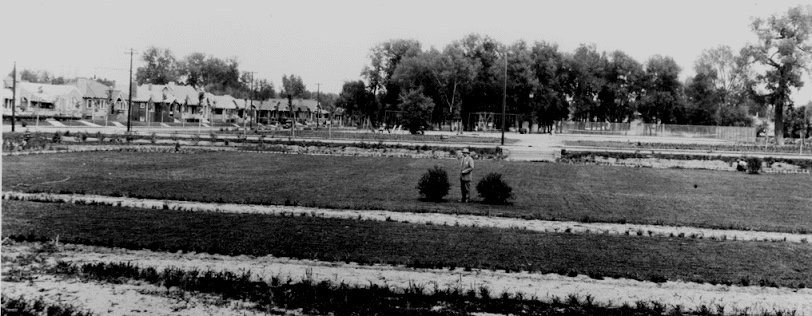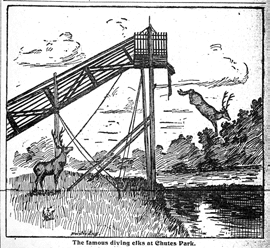
History and Architecture of the Alamo Placita Historic District
The history of the Alamo Placita Historic District tells the story of the 1860's prairie land along Cherry Creek, just three miles southeast of the new town of Denver. Farsighted investor Moses Hallett, an attorney from Illinois, bought the land in 1864. Hallett's quarter section of land became Arlington Park Addition, and later, Alamo Placita neighborhood. by 1887, Denver's southern city limit was the northern border of Hallett's claim, what is now East 6th Avenue. A road on the eastern edge of Hallett's land, called Hallett Road, is now Downing Street. In 1889, Hallett sold his land to the Arlington Park Land and Improvement Company and became one of several investors in the company.
Robert W. Speer (1855-1918)
Robert W. Speer came to the West in 1878 seeking a cure for his tuberculosis. He recovered and exhibited boundless energy that defied any earlier malaise. Speer is remembered for becoming Denver's first mayor under home rule in 1904. He is also remembered for his exuberance for Denver's City Beautiful Movement, his support for the Denver park syste, his boss-style politics, and his personal gains from real estate investments. Much less well known were Speer's important connections with the Alamo Placita neighborhood.
Those connections included, first, the fact that Alamo Placita neighborhood was Speer's first major real estate investment. He formed a syndicate to develop the land. When Arlington Park Addition was created, it became the first client for Speer's newly formed real estate company. Second, Speer's creation of an addition and then an amusement park provided him with experience as the central figure in pulling big plans together with powerful Denver men. Third, the neighborhood was his home. Robert and Kate Speer built their residence at 505 Clarkson Street (now demolished) in 1890, and lived there until 1906.
Arlington Park and Chutes Park
The grand opening for Arlington park was held on the Fourth of July in 1892. An extravagant theatrical production, "The Last Days of Pompeii," was the main attraction, involving 300 actors and a 54-foot high set of Mt. Vesuvius. When Vesuvius erupted, a large fireworks display accompanied the eruption. In true Speer style, the grandeur was heavily promoted and an estimated 12,000 people attended.
The future of Arlington Park looked bright, and surely more events were anticipated. Anticipation disappeared when the 1893 Silver Crash brought the economy to a standstill. In 1898, Arlington Park reopened under the name Chutes Park. The new feature was "the chutes," a graded waterfall that took riders in boats down into the lake at the bottom.
Two new attractions in May 1899 lured fun seekers. Miss Sadie Boynton, recently of Paris, France, would thrill all by "shooting the chutes" on a bicycle. Also, "Professor Barnes' much heralded herd of driving and diving elks" would march up a ramp and plunge, one at a time, off a 60-foot high platform into a tank of water. Handbills proclaimed the the park "The Coney Island of the West."
Fires in 1901 and 1902 closed the amusement park forever, pleasing nearby neighbors who found living near the facility quite trying.
Alamo Placita After World War II
With the building boom of the post-World War II years taking newer populations to the city fringe or new suburban communities, most of the Alamo Placita neighborhood continued to draw those who needed more affordable housing. Some developers demolished a few early residences to build more lucrative, multifamily apartments. Most of these new apartments were built on a relatively small scale.
According to Assessor records, by 1930 approximately 90 percent of the present Alamo Placita Historc District buildings were built; by 1940, ninety four percent were buit. These include single family dwellings, multifamily dwellings, and the few commercial building in the district.
Neighborhood development continued with change occurring at a very slow pace, reacting to the ups and downs of the economy. During the 1960's, 1970's and 1980's, the value of the neighborhood as a family-oriented environment close to the heart of the city was quietly rediscovered by young professionals and others. Lawyers, doctor, teachers, and businesspeople were moving into Alamo Placita in greater numbers, joining trade craftsmen, clerks, salesmen, and others. An example of one such couple is Richard and Dottie Lamm, who lived at 531 Emerson Street in the 1960's, before Lamm became a three-term governor of Colorado. The rediscovery of the neighborhood included an appreciation and respect for its architecture. Growing numbers of residents became aware of the neighborhood's architectural integrity. Their interest led to a desire to protect their environment and learn more about neighborhood history. This in turn formed the foundation for the creation of the Alamo Placita Neighbors Association.
Photos Courtesy of Western History Department, Denver Public Library. Excerpted and adapted from Application for Landmark Designation by Nancy Widmann, 1999. Special thanks to Joe Halpern for his contribution and compilation of neighborhood history.

